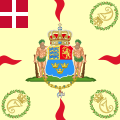| Prince's Life Regiment | |
|---|---|
| Prinsens Livregiment | |
 | |
| Active | 1961–2005 |
| Disbanded | August 2005 |
| Country | |
| Branch | |
| Role | Mechanized infantry |
| Size |
|
| Garrison/HQ |
|
| Motto(s) | Gloria Finis (Glory to the End) |
| Regimental belt | |
The Prince's Life Regiment (Danish : Prinsens Livregiment) was a Royal Danish Army infantry regiment. The motto of the regiment was "Gloria Finis" (Glory to the End).



